- Home
- Encyclopedia
- The 1918 Flu: A Pandemic Sweeps Wyoming
The 1918 Flu: A Pandemic Sweeps Wyoming
Though disease epidemics were common throughout America and the West in earlier times, the worst epidemic in terms of loss of human life came to Wyoming early in the 20th century, in the fall of 1918.
From October of that year through January 1919, 780 people died statewide, victims of the flu epidemic.[1]Of those, 169 died directly from the flu while the rest were taken by a combination of flu and pneumonia.[2]
The sickness came just as World War I was drawing to a close. The war had begun in 1914 and the United States had entered it in April 1917. Beginning early in 1918, in the space of 15 months the disease killed somewhere between 50 million and 100 million people worldwide—far more than the 20 million civilian and military deaths attributed directly to the war. In Wyoming, too, the flu was deadlier than the war: Around 11,000 Wyoming men served in the war; about 500 of them died.[3]
Strong evidence now appears to show the epidemic began in the United States, though some scholars argue for France, China or Vietnam. In the U.S., this flu was first reported in Haskell County, Kan., spread from there with army recruits to Camp Funston, Kan., a huge training base, from there through military posts across the country and finally, with American soldiers, to the theatres of war in France.[4]
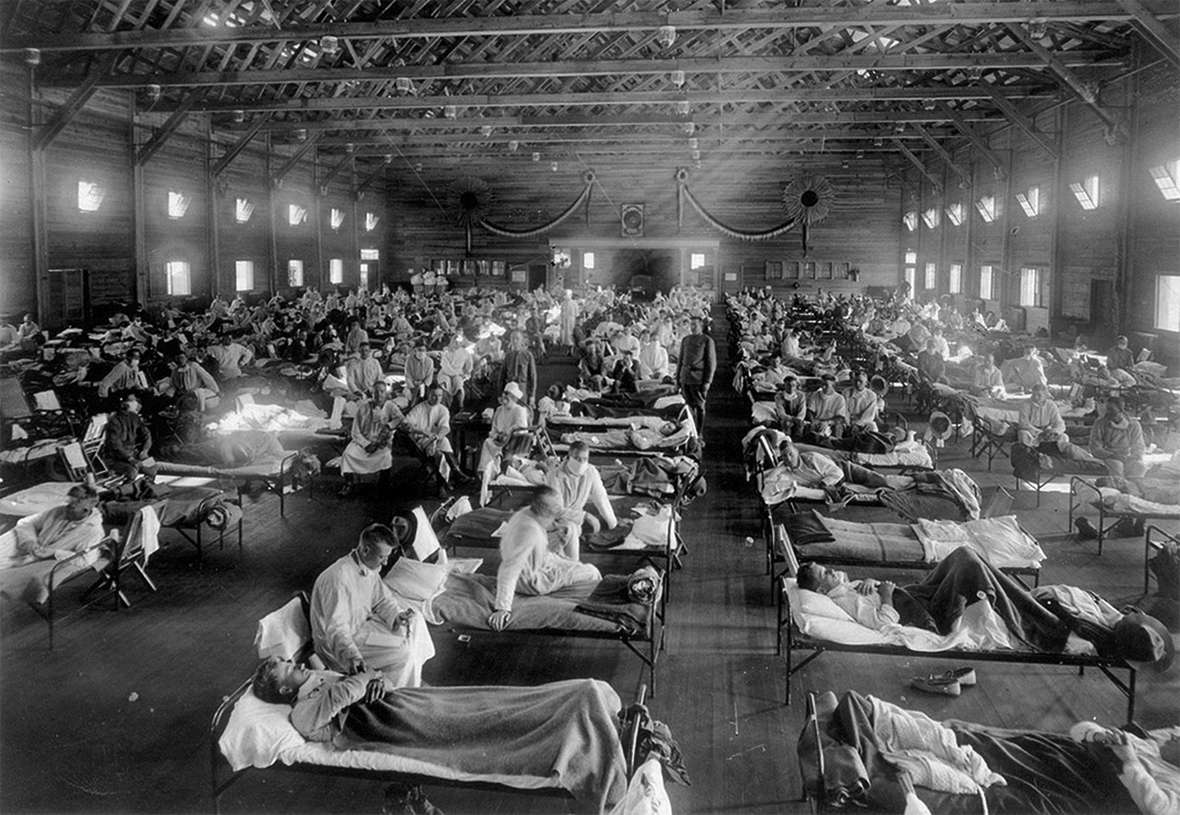
Though at the time it was called the Spanish Influenza or more often Spanish flu, the epidemic did not begin in Spain.King Alfonso XIII of Spain fell gravely ill after the flu was widely reported in Madrid in May 1918.Spain was not a combatant in the war, however, and, therefore, news of the epidemic was not censored there as it was in France, England, Germany and the United States. The king recovered, but the name "Spanish influenza," stuck.[5]
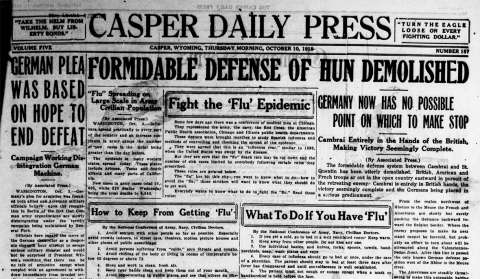
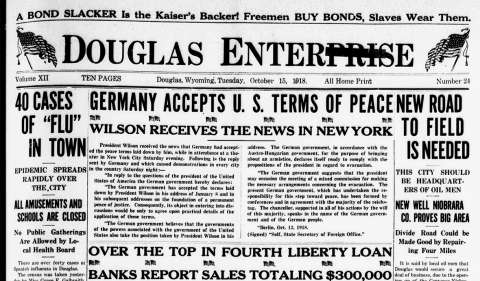
The epidemic came in three waves worldwide. The first, in the spring and early summer of 1918, was relatively mild. The second, beginning in summer and gaining vast momentum in the fall, was far deadlier. A third wave, in the winter and spring of 1919, was less lethal than the second but still dangerous.
The U.S. Army Surgeon General reported on Oct. 1, 1918, that all but 13 military installations in the continental United States were experiencing record numbers of soldiers ill with the flu. "Sick rates for [these forts], as a whole, are nearly double those of last week, due to the high incidence of epidemic influenza at Camp Devens, 8,653; Dix, 1,569; Upton, 920; Lee, 900; Gordon, 879; and Jackson, 561. The number of new cases in each are up."[6]
In that same month, October 1918, Wyoming newspapers reported dozens of deaths from the disease. The number of cases in Wyoming peaked prior to Armistice Day, Nov. 11, 1918, when the war ended and by which time some soldiers were beginning to return to their home towns. Many may have carried the germs home, accelerating the flu’s spread.[7]
Young and old die—but healthy adults also succumb
Young children and elderly died, but what made the epidemic unusual were the many deaths of healthy young adults.[8]The number of deaths in Wyoming stayed high in November. During the first week of the month, news statewide listed dozens of victims.[9]
Local and state public health officials drastically curtailed public activities—shopping was limited, schools closed and public and private gatherings were canceled, so fearful was everyone of the spread of the disease.
Many people got sick in late September and October. Just as schools were opening in September, officials noticed significant attendance decreases and, by mid-month, schools had closed in most counties. According to reports submitted to the Wyoming superintendent of public instruction the following May, these closures occurred statewide.[10] Reading them confirms the pervasive role the flu had on the state's schools, particularly during the fall term of 1918.
Volunteer war work slows
Volunteer war work dominated school life at the time. Schools had been expected to help with the war effort by assisting with Red Cross drives, but that work slowed or stopped.
Reports on these volunteer projects from county school officials to the state superintendent the following year provide a sense of how widespread flu had become.
"Owing to the influenza epidemic and the resulting quarantine,” wrote A.S. Jessup, city superintendent of Cheyenne schools, “little work has been done [on Red Cross war projects] since schools opened in September 1918, as the schools have been closed longer periods than they have been in session."[11]
"I know very little about the Big Piney schools since the epidemic of influenza kept me from seeing them this fall, " Margaret F. Nicholson, Lincoln County superintendent, wrote in her report of work by the Junior Red Cross.[12]

In Natrona County, war work in the schools stopped entirely in October.[13]Nellie L. Underwood, superintendent in Park County, noted that Red Cross work had gone well in the spring. In the fall, though, "The schools were quarantined so shortly after they had begun, that reports are not available for this year."[14]
Similar mentions were made in reports from superintendents in Platte; Sheridan; Sweetwater; and Uinta county: "Our schools were in session but one month when we closed on account of influenza. We have not opened yet."
A high school reporter for the Newcastle News-Journal wrote, "On account of the Spanish Influenza epidemic we are going to postpone our war advertising fair for another week."[15]The Cokeville Register also carried the news, stating, "The schools in Afton have been closed, pending an investigation of sickness which has broken out there."[16]
Wyoming deaths occur during a four-month period
Many died during the last two weeks of October and the first week of November, by which time, according to some national news accounts, the epidemic was declining. That appeared not to be the case in Wyoming, however. Reports of disease and flu deaths continued unabated at least until January 1919. A few newspaper editors noted that schools, closed for the semester, were about to reopen in December, but most did not begin sessions until after the Christmas holidays.
University of Wyoming suspends classes
The University of Wyoming suspended classes and shut down in early October with a formal notice reported in the Wyoming Student. "The culmination of the growing epidemic of Spanish influenza throughout the city came on the afternoon of Tuesday a week ago,” the article noted, “when the health authorities ordered all places of amusement, all public gatherings, and all schools closed until further notice.”
According to the report, Dr. Aven Nelson, president of the university, “suggested that the enforced vacation would offer excellent opportunity for reading and outdoor exercise, and that if used to catch up on the things for which the ordinary routine does not give time, it would not prove too irksome."[17]Pointing out that officials discouraged students from spending time downtown, the editor observed, "... since the soda fountains and picture shows are also closed, there is not a great deal of inducement to loiter on the street."
Statewide, of the stores that remained open, many limited the number of customers. Some Cheyenne stores allowed only five customers at any one time for each 25 feet of store front.[18]
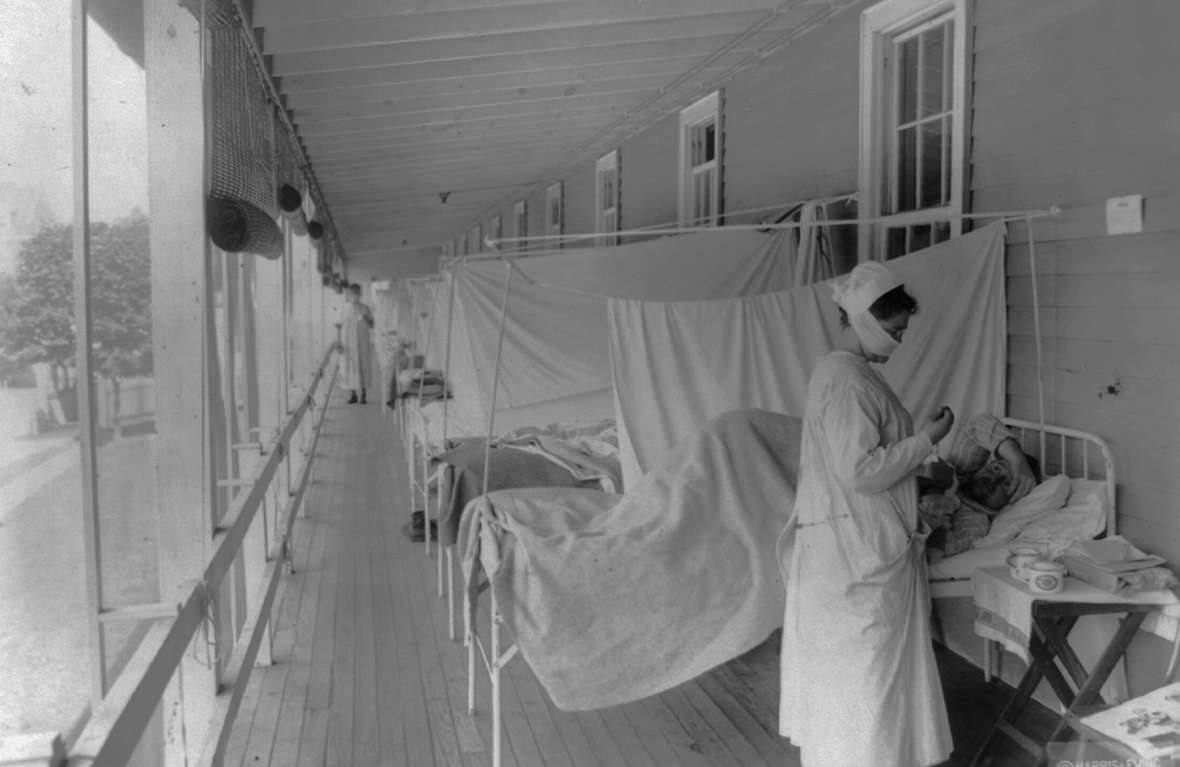
Obituaries fill newspapers
Throughout the fall, reports of deaths filled local newspapers. In mid-October, the Wyoming Student noted the flu death of recent UW graduate, Lt. Ben Appleby at Camp Dodge in Iowa while in training to leave for the war. The 25-year-old soldier had been student union president, editor of the annual, a champion debater and major in the university's ROTC Cadet Corps.[19]
The Newcastle newspaper reported October 24 the deaths of Carroll Jefferis, a 28-year-old druggist, who died only a few days after contracting the disease and Frank Davis, 32, a rancher southeast of Newcastle, who died in Edgemont, S.D., earlier in the week. Like other weekly community papers, the Newcastle News Journal also printed the names of many people who were ill with the disease.[20]
Across the state in what’s now Sublette County, a previously healthy 32-year-old cowboy became ill out on the range on an October Friday and died three days later.[21]In northern Wyoming, a Sheridan paper reported in November that in a 24-hour period "Five Deaths Occur as Result of Flu." Two victims were middle-aged women; one was a 20-year-old woman; two were children.[22]In south central Wyoming, prominent Saratoga businessman Charles Pennock, after ten days with the flu, died in early November at the age of 37. He was reportedly unconscious for 48 hours before his death.[23]
The epidemic swept the Big Horn Basin, too. On Nov, 8, The Thermopolis Independent reported five deaths from flu over the previous week. One woman was just 21 and recently married. The other four victims included two miners from the coal mining town of Gebo; the mother of four children in Thermopolis; and a 20-year-old Ohio man working in the same town. A sixth man was reported to have died just before press-time.[24]A sheepherder, Michigan-born Charles E. English, died in Basin. The Basin Republican reported the flu death of a 16-year-old high school student, Robert Steele. Both had been in good health prior to contracting the disease in late October.[25]
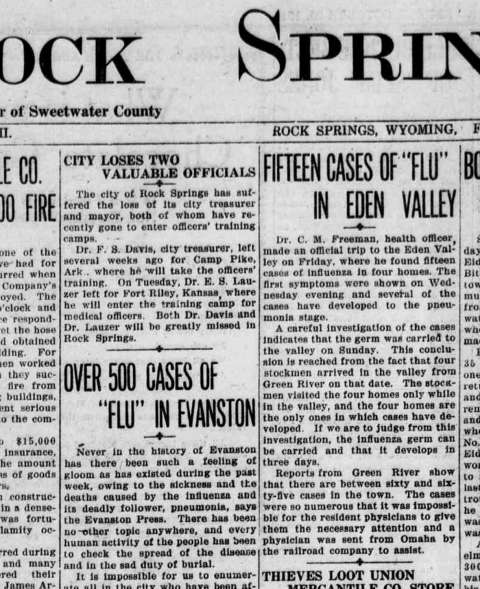
Rock Springs papers reported on Nov. 8 that a 34-year-old miner in Winton died from flu as well as two Mexican herders. "Paulo Esquibal, a Mexican, died at the emergency hospital on Saturday evening from influenza. Another Mexican, Mareos Sanchez, also died at the emergency hospital on Monday, from the same disease. Both men had been employed on the Gottsche ranch for the past three years. ..."[26] Northern Wyoming experienced deaths as well. The Gillette newspaper noted that two men, both in their early 20s, died of flu in Gillette that week.[27]
Two towns were particularly hard hit with flu in late October. In Hudson, Wyo., in Fremont County, "over a third of the coal miners are off either as the result of having the flu themselves or in their immediate family,” the Wyoming Labor Journalreported. Union local President Adam Rodgers died from the disease.[28]
The second hard-hit town hard that week was Cokeville. "The public schools were closed Friday afternoon and will not re-open until all danger is past,” the Cokeville Register reported on Oct. 12, adding: "Commencing today, all public gathering will be under ban until further notice." The Kemmerer newspaper reported that up to 125 people had contracted the disease. The Wyman Hotel was temporarily a Red Cross hospital. Two Cokeville residents died from flu.[29]
Statewide, some suggestions to alleviate the spread of the disease seem far-fetched. "In the belief that smoke might carry the disease," Wyoming historian T.A. Larson later wrote, "leaf burning was forbidden."[30]
By late fall, some Wyoming places thought they had escaped the flu epidemic. A stringer for the Lusk newspaper reported that nearby Van Tassell, Wyo., “found herself in the grip of the 'Flu' just as we began to think that that germ was going to overlook us. So far there have been three victims, and we are praying and working, each in their own way, that we may be spared any farther fatalities."[31]
Some towns resort to quarantines
Because reports from other area towns told of the dire consequences of the disease, some towns managed to escape widespread influenza by imposing quarantines and cancelling public events before the disease made its appearance.
In October, the town council of Kemmerer quickly imposed a quarantine. "There can be little doubt that our good fortune is due to the prompt and wise action taken by the Town officials and the local health officers when the epidemic first became prevalent in Evanston," a Kemmerer editor noted, but added that it was not without economic consequences. Local businesses suffered, many “ being entirely closed on account of the restrictions," the editor concluded.[32]This pattern was repeated in towns throughout the state.
Cokeville authorities imposed a quarantine in late October, and warned visitors from other towns to stay away. As the Cokeville Register reported on Nov. 2: City Health Officer Madera requested that other towns make sure no tickets to Cokeville be sold. Richard Roberts, the newspaper reported, was appointed a special officer, to impose a three-day quarantine on anyone arriving from outside the town. Some residents began wearing gauze masks when moving around the town.[33]
The Cokeville quarantine finally ended in November. "[L]ast Wednesday saw smiles on the faces of all,” the Register reported, with no new cases for a full week. “During the quarantine, business has practically been at a standstill, several of the establishments suffering a total loss of customers during the time they were closed. The merchants are to be thanked for the generous manner which they have observed the regulations." The editor also thanked the local population: "The men have done their part freely, and the ladies have spent long hours nursing and caring for the invalids.”[34]
Flu strikes some as late as December 1918
The epidemic was slow in coming to some places. During the first week of December 1918, the disease caused 14 deaths in Washakie County, previously relatively immune from the disease. “Conditions in Worland look considerable brighter today than they have for the past ten days, scarcely any new cases are reported the last three days and it looks as though the epidemic is now under control," the editor of the Worland Grit wrote Dec. 12, listing the names of the 14 people who died.[35]
Work slows and stalls
Workplaces statewide were disrupted. The Wyoming Labor Journal noted, "There has been no part of the state that has been immune nor has any particular class of people been favored. There have been a number of deaths, but in the majority of instances where proper care has been taken the worst result has been from the incapacitating of the victims."[36]
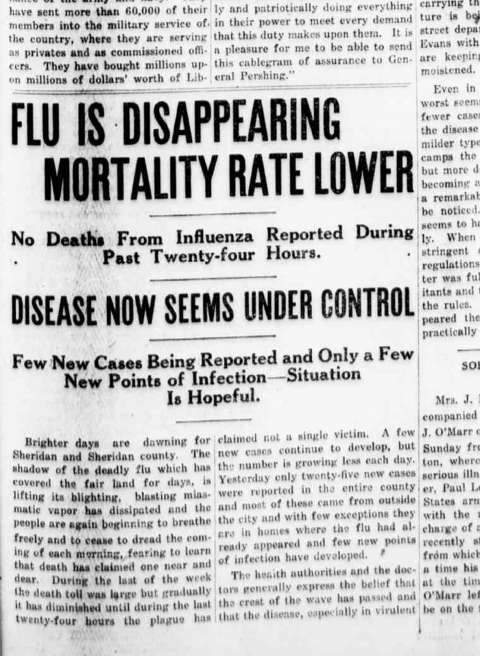
The labor publication further noted, "Union activities have been practically at a stand still during the epidemic, owing to the suspension of meetings, but, except in the case of the newer unions of the railway shop crafts organized by the Federation officers and which have had no opportunity to become familiar with their procedure, little inconvenience has resulted." The labor publication, distributed statewide, concluded: "The locals particularly affected in this manner have been those of the Maintenance of Way Employees at Green River, Sheridan and Greybull, the Carmen at Greybull; the Federal Union of Railway Laborers and Helpers at Cheyenne. The older locals have their affairs so well in hand that they can transact their ordinary business for any ordinary period without the necessity of stated meetings."[37]
Typically, victims in work places were previously healthy younger men. For example, William Addison Burke, 24, a conductor for the Union Pacific Railroad, died of the flu on Oct. 22. According to his obituary in a Laramie newspaper, he had been operating trains between Laramie and Rawlins up until the week before his death. As the paper reported, the source of Burke's disease may have come from family members serving in the military and posted where flu was especially prevalent: "As a railroad conductor, he was exempted from the draft just two weeks before his death. Three of his brothers were in military service."[38]
State health authorities support longer quarantines
By mid-December, state health authorities were still urging that quarantines continue because "Spanish influenza is beginning to spread again in many locations ..."[39]In a detailed letter to county public health officials in Wyoming's then 21 counties, C.Y. Beard, secretary of the Wyoming State Board of Health, wrote of the dangers of lifting quarantines too soon:
"Many inquiries are being made by teachers of the different counties as to the probable day of the opening of the schools. The County Health Officers are instructed to give no encouragement regarding this as indications do not point to an early opening of the schools and when the order is issued it will probably not be one applying to all schools in the state." Beard urged that patients be isolated and warned "against negligence in reporting new cases toward the end of the epidemic." He said that each physician "in your district be supplied with a number of placards to tack up himself on running across cases in an isolated district, that the public may have knowledge of the existence of the disease in their neighborhood."
The Beard letter continued: "Public sales have been a great menace to the proper control of the disease and you are urged to stop all public sales in your district until after the schools and other public places are opened. Some sections of the state insist upon continuing card parties and social gatherings which is also condemned and the ruling must be enforced." Beard reminded health officers of fundamental public health principles, including sterilization of utensils used in serving food and drink to the public."[40]
Meanwhile, a few newspapers published articles about the possibility of a vaccine, "but we feel that most people are still doubtful about its value," the Dwyer Heraldreported.[41]The Casper Record printed an article stating that eating lemons would keep people from contracting the disease.[42]
Deaths continue
As late as Jan. 8, 1919, reports continued on the deaths caused by influenza. A Thermopolis paper noted: "Entering the home of a neighbor a few days ago J. B. Baer, of Ismay, found the farmer and his wife with two children lying dead in their beds, a third child dying on the floor. All were victims of influenza. The last child died shortly after he had been taken to another ranch for treatment. Indications showed that the entire family had been stricken together and had died partly from starvation, being unable to help each other."[43]
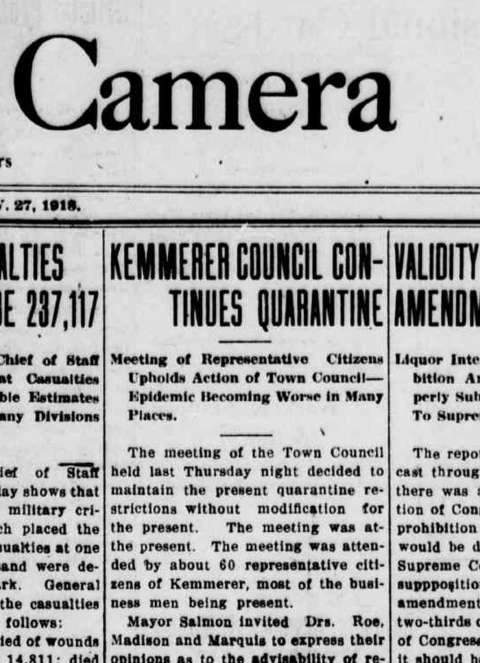
Officials were still concerned about the epidemic after the New Year. When theaters and churches were allowed to reopen in January 1919, people occupied only alternate seats.[44] The last Wyoming cases were reported in the early winter of 1919, although precautions were still in place in most Wyoming schools and towns until the following summer. By spring, no more cases were reported. Still, the following fall, many people were wondering if the flu would return.[45]
It didn't, at least in Wyoming. However, the state continued to experience lesser epidemics of other diseases. Polio, for example, struck many victims in Wyoming in the early 1950s. Newly discovered vaccines put an end to its presence about 1957.[46]
Questions remain
The death toll from the flu epidemic of 1918 has been measured for many states.[47]Inexplicably, Wyoming is not included in the government listing. The Wyoming Board of Health claimed some 700 people died from the flu or its effects; historian T.A. Larson placed the figure at 780. Random samples of cemetery records and newspaper obituaries from the period confirm a number in that range.
A century later, the question about how such an epidemic might affect Wyoming continues to be raised. Historian John M. Barry predicted the impact of such an epidemic nationally. "If a new influenza virus does emerge, given modern travel patterns, it will likely spread even more quickly than it did in 1918,” Barry writes.[48]
Improvements in modern medicine and innovations in treatment and prevention will likely make a difference in that event. But preventive measures such as vaccinations, in order to be effective, must be practiced by the entire population if epidemics are to be controlled. Much medical research has been made during the century after flu swept across the world and Wyoming the fall of 1918, but to avoid disease, individuals and communities must continue to take precautions.
Here is a poem that appeared on the front page of the Guernsey Gazette on Jan. 3, 1919, after the flu epidemic had alleviated somewhat:
"According to
THE FLU
When your back is broke and your eyes are blurred
When your shin bones knock and your tongue is furred
And your tonsils squeak and your hair gets dry.
And you're doggone sure that you're going to die
But you're skeered you won't and you're afraid you will
Just drag to bed and have your chill
And pray the Lord to pull you thru
For you've got the Flu boy. You've got the Flu.
When your toes curl up and your belt goes thin;
And you're twice as mean as a Thomas cat,
And life is a long, long dismal curse,
And your food all tastes like a hard boiled hearse;
When your lettice aches and your head's abuzz,
And nothing is as it ever was,
Here are my sad regrets to you
For you've got the Flu, boy. You've got the Flu.
What is it like? This Spanish Flu?
Ask me, brother, for I've been thru.
It is by misery out of Despair
It pulls your teeth and curls your hair;
It thins your blood and brays your bones
and fills your craw with moans and groans
And sometimes maybe you get well
Some call it flu, I call it hell."
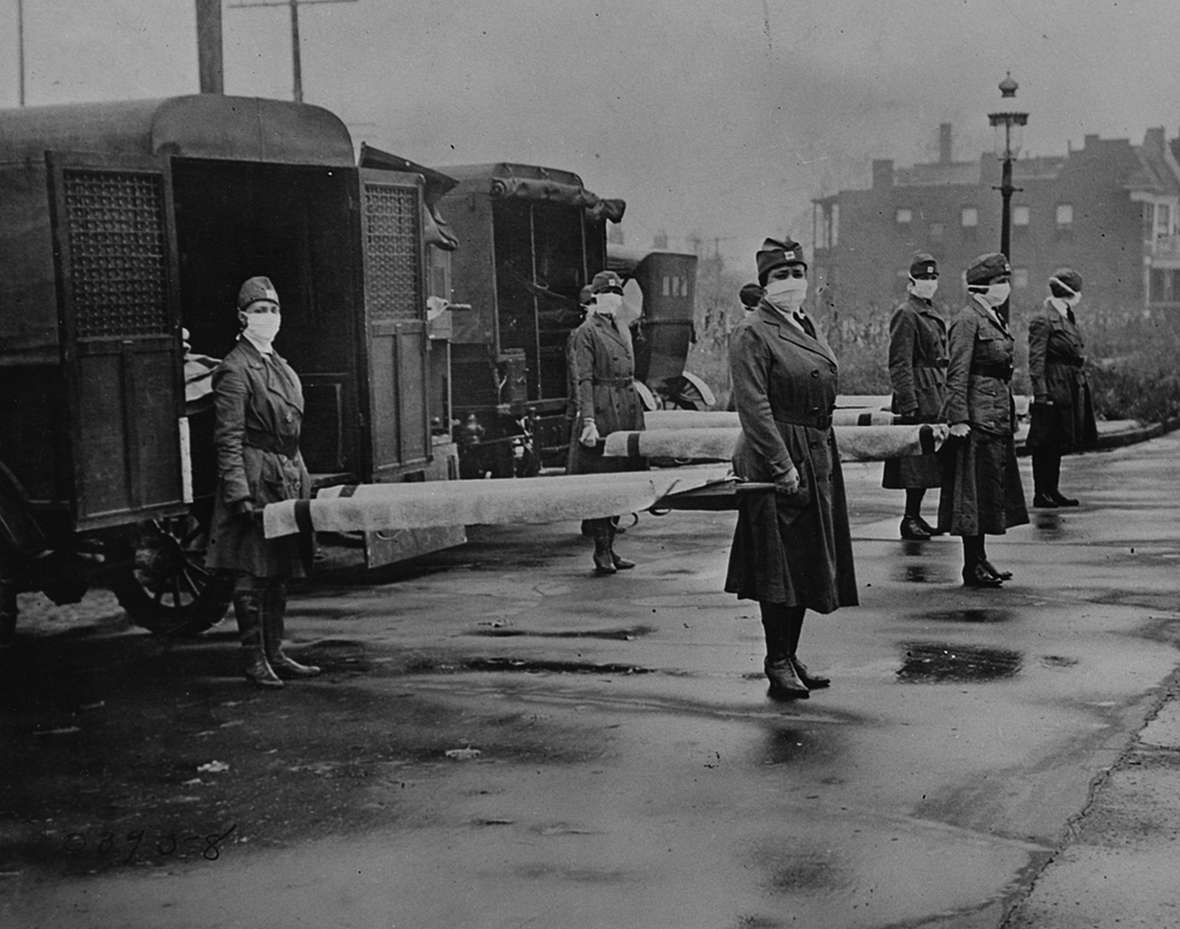
Resources
- Newspapers: The following Wyoming newspapers—referenced with dates in the footnotes for this article—are also available online at http://newspapers.wyo.gov:
- Basin Republican
- Big Piney Examiner
- Casper Daily Press
- Casper Record
- Cokeville Register
- Douglas Budget
- Dwyer Herald
- Gillette News
- Guernsey Gazette
- Jackson Hole Courier
- Kemmerer Camera
- Kemmerer Republican
- Laramie Boomerang
- Laramie Semi-Weekly Republican
- Lost Spring Times
- Lusk Herald
- Manville News
- Newcastle News-Journal
- Powell Tribune
- Rawlins Republican
- Rock Springs Miner
- Saratoga Sun
- Sheridan Enterprise
- Thermopolis Independent
- Wind River Mountaineer
- Worland Grit
- Wyoming Labor Journal
- Wyoming Student
- Wyoming Times
- Barry, John M. The Great Influenza. New York: Viking, 2004.
- ___________. “How the Horrific 1918 Flu Spread Across America.” Smithsonian Magazine, November 2017. Accessed Sept. 19, 2018 at https://www.smithsonianmag.com/history/journal-plague-year-180965222/.
- Crosby, Alfred W. America's Forgotten Pandemic: The Influenza of 1918. Cambridge University Press, 1989.
- Gould, Gertrude. History of Health and Hospitals in Albany County, Wyoming. Privately printed, 1973.
- Hayes, Shaun. Former University of Wyoming American Heritage Center archivist, currently University of Wisconsin-Milwaukee archivist, Wyoming Humanities Council presentations 2011-2012.
- Hunt, Rebecca A. Wyoming Medical Center: A Centennial History. Virginia Beach, Va.: Donning Co. Publishers, 2011.
- Larson, T.A. History of Wyoming, 2d ed., rev. Lincoln, Neb.: University of Nebraska Press, 1977, 404.
- Linford, Ernest H. "Flu Epidemic of '18 Recalled," Casper Star-Tribune, April 9, 1974.
For further reading and research
See also Albany County historian Kim Viner's article, "Spanish Flu" Epidemic Hits Laramie--1918," at https://www.wyoachs.com/a-variety-of-other-topics/2020/4/3/spanish-flu-e...
Illustrations
- The photo of Red Cross nurses with stretchers is from the Library of Congress. Used with thanks.
- The photo of the nurse checking a pulse is likewise from theLibrary of Congress. Used with thanks.
- The photo of flu victims on cots is from the National Museum of Health via the Atlantic. Used with thanks.
- The newspaper images are all from the Wyoming Newspaperswebsite. Used with thanks.
[1]T.A. Larson, History of Wyoming, 2nd ed., rev. (Lincoln: University of Nebraska Press, 1978), 404.
[2]Numbers are from T.A. Larson, History of Wyoming, 2nd ed., rev. (Lincoln: University of Nebraska Press, 1978), 404. Wyoming’s population at the time was around 181,000. Flu and flu-related deaths, therefore, would have killed around four-tenths of 1 percent of the state’s people, a far smaller proportion than died over two decades of travel on the emigrant trails across the West—the great majority of them from cholera and other diseases.
[3]Larson, 395-396.
[4]Barry, John, “How the Horrific 1918 Flu Spread Across America,” Smithsonian Magazine, November 2017.
[5]Many other European countries experienced flu epidemics earlier, but all were under wartime censorship, according to some historians. King Alfonso XIII of Spain was made gravely ill by it soon after it was reported in Madrid in May 1918.Spain was outside the main war zones and, therefore, news of the epidemic was not censored there. The king recovered, but the name "Spanish influenza," stuck.
[6]"Influenza Sweep Doubles Rate of Deaths in Camps," Laramie Boomerang, Oct 1, 1918, 1.
[7]This assessment was made by many contemporary sources and noted by later historians. Shaun Hayes, former archivist at the American Heritage Center and now archivist at the University of Wisconsin, Milwaukee, referred to this theory of the spread of the disease in public lectures sponsored by the Wyoming Council for the Humanities in 2011.
[8]Crosby describes deaths concentrated among those 21-45 years old, chap. 2. Barry notes that in Louisville, Ky., 40 percent of the victims were aged 20-35, see Barry, 173.
[9]"Biennial Report," State Superintendent of Public Instruction (Cheyenne: State of Wyoming, 1917-18), 25, 27, 28, 29.
[10]"Biennial Report," State Superintendent of Public Instruction (Cheyenne: State of Wyoming, 1917-18). The main theme that year for the biennial reports was for county superintendents to report on how schools had proceeded with projects for the war effort, including Red Cross programs, but all reports indicated the pervasive problem of flu.
[11]"Biennial Report," 21.
[12]"Biennial Report," 22.
[13]"Biennial Report," 22-23.
[14]"Biennial Report," 25.
[15] "High School Notes," Newcastle News-Journal, Oct. 10, 1918, 1.
[16]Cokeville Register, Oct. 12, 1918, 1.
[17] "Work Suspended to Halt Disease," Wyoming Student(UW), Oct. 17, 1918, 1.
[18]Ernest H. Linford, "Flu Epidemic of '18 Recalled," Casper Star-Tribune, April 9, 1974.
[19] "Lt. Ben Appleby (under portrait)" Wyoming Student(UW), Oct. 17, 1918, 1.
[20]Newcastle News Journal, Oct. 24, 1918, 1.
[21]Big Piney Examiner, Oct. 31, 1918.
[22]Sheridan Enterprise, Nov. 7, 1918, 1.
[23]Saratoga Sun, Nov. 7, 1918, p. 1.
[24]"Young Woman Dies After Brief Illness," Thermopolis Independent, Nov. 8, 1918, 1.
[25]Basin Republican, Nov. 8, 1918, p. 1.
[26]"Two Mexican Herders Die from Influenza," Rock Springs Miner, Nov. 8, 1918, 1.
[27]Gillette News, Nov. 8, 1918, p. 1.
[28]"Flu in Hudson Cuts Down Force," Wyoming Labor Journal, Nov. 8, 1918, 1.
[29]"Flu Epidemic in Cokeville Very Serious," Kemmerer Republican, Nov. 8, 1918, 1.
[30]Larson, 404.
[31]Lusk Herald, Nov. 7, 1918, p. 1.
[32]"Kemmerer Council Continues Quarantine," Kemmerer Camera, Nov. 27, 1918, 1.
[33]Cokeville Register,Nov. 2, 1918, 1.
[34]Cokeville Register, Nov. 23, 1918, 1.
[35]"Influenza Epidemic Take Toll in This Community," Worland Grit, Dec. 12, 1918, 1. Those listed as victims were: Don Romero, "a Mexican aged 31 years"; Donald Mitchell, 18; Joe I. Vokoto, "a Japanese boy 22 years of age"; Edward Maisch, 23; Ray Cogdill, 24, "he was ill only a short time"; Jules Bernard, 33, "sheepman from Ten Sleep ... died in Worland"; Fred Noble, "head of Noble and Bragg outfit on Nowood ... died in Elko, Nevada"; Harry Sands, owner of merchandise store in Chatham; Mrs. Thomas Mills, 50, Tensleep; Mirl V. West, 21; Edward E. West, 2, "3rd to die out of one family"; Donald Cogdill, 2; Bertie Brown, 19; Mary Mein, mother of two young children; Mason A. Hess, 51, Durkee rancher; Pauline Morland, 32, "leaves a husband and six children"; Torrey Packer, 24, "lived on the west side of the river from town."
[36]Wyoming Labor Journal, Nov. 8, 1918, 1.
[37]Wyoming Labor Journal, Nov. 8, 1918, 1.
[38]Laramie Semi-Weekly Republican, Oct. 26, 1918, 3.
[39]"Quarantine for Flu," Worland Grit, Dec. 12, 1918, 6.
[40]This account is from the Douglas Budget, Nov. 7, 1918, with Dr. J.P. Keller reporting on the letter he received from C.Y. Beard, secretary of the Wyoming State Board of Health, relative to the lifting of the ban.
[41]"Vaccine for the Influenza," Dwyer Herald, Nov. 29, 1918, 1.
[42]"Hand the Flu a Lemon," Casper Record, Oct. 9, 1918, 1.
[43]"Entire Family Succumbs To Spanish Influenza," Thermopolis Independent, Jan. 10, 1919, 8.
[44]Larson, 404.
[45]Powell Tribune, Sept. 26, 1919, 9.
[46]For a brief list of epidemics in Wyoming, see Wyoming Almanac, 5th ed. (Laramie, 2013), 309-10. For impact of specific epidemics on local health, see Gertrude Gould, History of Health and Hospitals in Albany County, Wyoming(privately printed, 1973); Rebecca A. Hunt, Wyoming Medical Center: A Centennial History(Virginia Beach, Va.: Donning Co. Publishers, 2011).
[47]U.S. Bureau of the Census, Mortality Statistics, 1919. (Washington: GPO, 1921), 28-31.
[48]Barry, The Great Influenza, 450.
